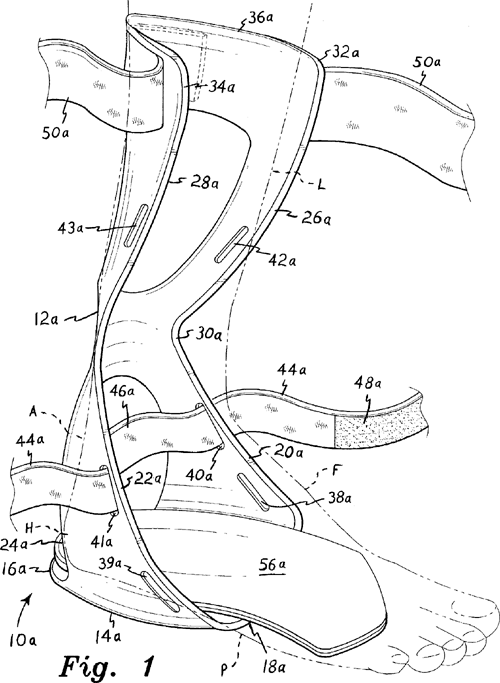
Definition: Functional Electrical Stimulation (fixing Drop Foot)
from Wikipedia, the Free Encyclopedia
Functional electrical stimulation (FES) is a technique that uses electrical currents to activate nerves innervating extremities affected by paralysis resulting from spinal cord injury (SCI), head injury, stroke and other neurological disorders. FES is primarily used to restore function in people with disabilities. It is sometimes referred to as Neuromuscular electrical stimulation (NMES).
 FES was initially referred to as Functional Electrotherapy by Liberson, and it wasn't until 1967 that the term Functional Electrical Stimulation was coined by Moe and Post, and used in a patent entitled, "Electrical stimulation of muscle deprived of nervous control with a view of providing muscular contraction and producing a functionally useful moment". Offner's patent described a system used to treat foot drop.
FES was initially referred to as Functional Electrotherapy by Liberson, and it wasn't until 1967 that the term Functional Electrical Stimulation was coined by Moe and Post, and used in a patent entitled, "Electrical stimulation of muscle deprived of nervous control with a view of providing muscular contraction and producing a functionally useful moment". Offner's patent described a system used to treat foot drop.
The first commercially available FES devices treated foot drop by stimulating the peroneal nerve during gait. In this case, a switch, located in the heel end of a user's shoe, would activate a stimulator worn by the user.
Common Applications
Spinal Cord Injury
Injuries to the spinal cord interfere with electrical signals between the brain and the muscles, resulting in paralysis below the level of injury. Restoration of limb function as well as regulation of organ function are the main application of FES, although FES is also used for treatment of pain, pressure, sore prevention, etc.Some examples of FES applications involve the use of Neuroprostheses that allow people with paraplegia to walk, stand, restore hand grasp function in people with quadriplegia, or restore bowel and bladder function.
Stroke
FES is commonly used in foot drop neuroprosthetic devices.In the acute stage of stroke recovery, the use of cyclic electrical stimulation has been seen to increase the isometric strength of wrist extensors. In order to increase strength of wrist extensors, there must be a degree of motor function at the wrist spared following the stroke and have significant hemiplegia.
Patients who will elicit benefits of cyclic electrical stimulation of the wrist extensors must be highly motivated to follow through with treatment, After 8 weeks of electrical stimulation, an increase in grip strength can be apparent. Many scales, which assess the level of disability of the upper extremities following a stroke, use grip strength as a common item. Therefore, increasing strength of wrist extensors will decrease the level of upper extremity disability.
Patients with hemiplegia following a stroke commonly experience shoulder pain and subluxation; both of which will interfere with the rehabilitation process. Functional electrical stimulation has been found to be effective for the management of pain and reduction of shoulder subluxation, as well as accelerating the degree and rate of motor recovery. Furthermore, the benefits of FES are maintained over time; research has demonstrated that the benefits are maintained for at least 24 months.
See the full article Functional Electrical Stimulation from Wikipedia, the Free Encyclopedia.
SSTattler will show the following 1) Bioness and 2) Walkaide. See many more devices in the last week article:
"Article: Dean - Hanger Completes Enrollment Of Walkaide Instride Clinical Trial".
Intro to Bioness Foot Drop System (Drop Foot)
http://www.bioness.com - Intro to L300 Foot Drop System.This system helps people with foot drop (drop foot) caused by damage to Central Nervous System (stroke, MS, brain injury, spinal cord injury).
L300 Foot Drop System - Healthcare Community Testimonials
http://www.bioness.com - L300 Foot Drop System - Healthcare Community Testimonials.This system helps people with foot drop (drop foot) caused by damage to Central Nervous System (stroke, MS, brain injury, spinal cord injury).
Bioness L300
The NESS L300 is an advanced foot drop system designed to use mild stimulation to lift your foot to help you walk more safely and easily. If the NESS L300 is right for you, it may be easier to walk on flat ground, up and down stairs, as well as on uneven surfaces. This light-weight device is designed to fit just below your knee and to be put on and taken off with one hand. Use of the NESS L300 may eliminate the need to wear a rigid, heavy orthosis.Bioness L300 Foot Drop System Making A Difference - Video 4
http://www.Bioness.com - Bioness NESS L300 Making A Difference - comparison of walking with stimulation vs. no stimulation.Bioness L300 Foot Drop Commerical - 60 second
http://www.bioness.com - Now there is a way to regain your freedom and independence by helping you walk with greater speed, stability and confidence.1 The award-winning L300 Foot Drop System is designed to help people with certain neurological conditions walk more naturally, with increased speed and improved balance.The L300 Foot Drop System Lifts the Foot and Helps People Living with Multiple Sclerosis (MS), Stroke, Brain Injury, and Spinal Cord Injury.
WalkAide treats Foot Drop using Myo-Orthotics Technology
WalkAide is a medical device that, after more than a decade in development, has received marketing clearance from the FDA for improving walking ability of people suffering from Foot Drop. Foot Drop is a condition caused by weakness or paralysis of the muscles involved in lifting the front part of the foot, which causes a person to drag the toe of the shoe on the ground or slap the foot on the floor.Invented by a team of researchers at The University of Alberta, WalkAide simulates the typical nerve-to-muscle signals in the leg and foot, effectively lifting the toes at the appropriate time. The resulting movement is a smoother, more natural and safer stepping motion, and faster walking for longer distances with less fatigue. In fact, many people who try WalkAide experience immediate and substantial improvement in their walking ability, which increases their mobility, functionality, and overall independence.
The New WalkAide System: Advanced Functional Electrical Stimulation (FES) for Treatment of Foot Drop
The New WalkAide System is a sophisticated functional electrical stimulation (FES) device for the treatment of foot drop caused by upper motor neuron injury, Such as Multiple Sclerosis (MS), Stroke (CVA), Incomplete Spinal Cord Injury, Cerebral Palsy (CP), and Traumatic Brain Injury (TBI).Utilizing a patented tilt sensor technology, the WalkAide stimulates the appropriate nerves in the leg causing the foot to lift at the right time during the walking cycle, prompting a more natural, efficient, and safe walking pattern, with or without footwear.






















